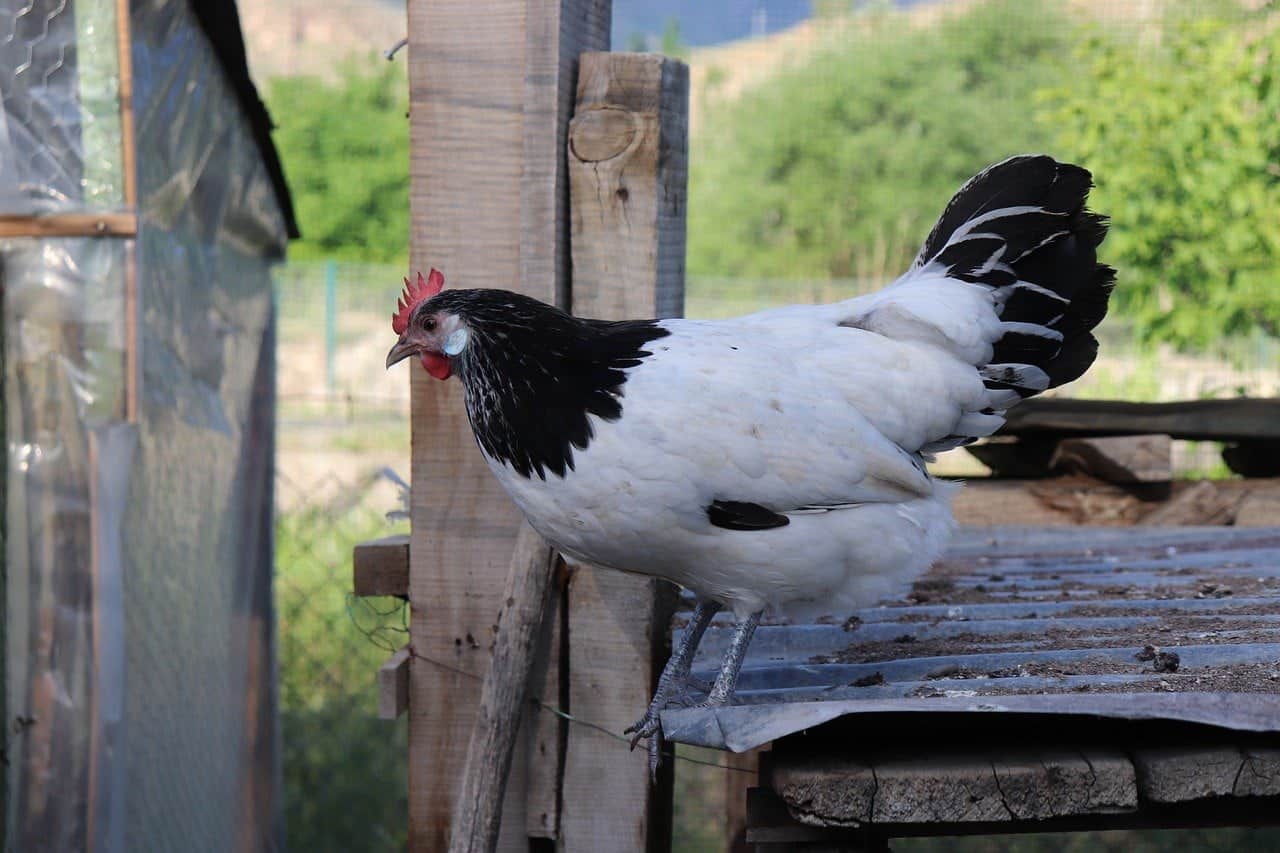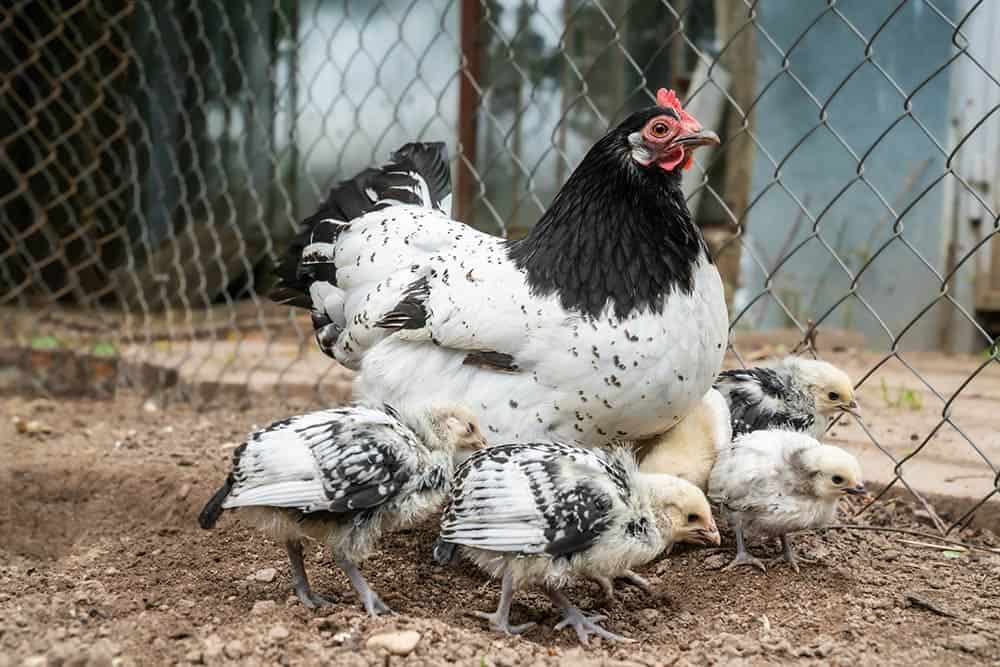Are you thinking about adding a Lakenvelder chicken to your flock? This guide will give you all the information you need to decide if this is the right bird for you. We’ll cover everything from history and characteristics to diet and care needs. By the time you finish reading, you’ll be able to make an informed decision about whether a Lakenvelder chicken is the right fit for your backyard farm!

Quick Facts about Lakenvelder Chickens
| Breed Name: | Lakenvelder Chicken |
| Place of Origin: | The Netherlands |
| Uses: | Eggs |
| Rooster Size: | 5 lbs. |
| Hen Size: | 4 lbs. |
| Color: | Black and white |
| Lifespan: | 6-8 years |
| Climate Tolerance: | Warmer climates |
| Care Level: | Easy |
| Production: | Up to 200 eggs per year |
Lakenvelder Chicken Origins
The Lakenvelder is a chicken breed that originates from the Netherlands. The name “Lakenvelder” comes from the Dutch words for “lake field” because these birds were traditionally found in the marshy areas around lakes. The Lakenvelder is thought to be a descendant of the Dutch Landhuhn, which was brought to Europe by Spanish traders in the 16th century.
The Lakenvelder made its way to America in the late 1800s and quickly became a popular choice for small farms and backyard flocks. These birds are known for their beautiful black-and-white feather patterns, which earned them the nickname “painted ladies.”


Lakenvelder Chicken Characteristics
Lakenvelders are relatively small birds, weighing in at around 4 pounds for hens and 5 pounds for roosters. They are good egg layers, producing up to 200 eggs per year. These chickens are also known for being friendly and docile, making them a great choice for families with small children.
Lakenvelders are generally healthy birds. However, like all chickens, they are susceptible to common poultry diseases such as Marek’s disease and avian influenza. They’ll need vaccinations, and you may also need to take them to the vet if they are sick or injured.
When it comes to diet, Lakenvelders are not picky eaters. They will happily eat a variety of fruits, vegetables, and grains. However, they do need access to plenty of fresh water throughout the day. In the wild, Lakenvelders will forage for food. This includes eating insects, small reptiles, and other small animals. In captivity, Lakenvelders should be provided with a diet that consists of:
- Fruits
- Vegetables
- Grains
- Fresh water

Uses
Lakenvelders are good egg layers, producing up to 200 eggs per year. Although Lakenvelders are typically raised for egg production, they can also be used for meat. These birds have a dark meat that is flavorful and juicy, but their small bodies don’t contain much meat, so you’ll need a lot of them.
Appearance & Varieties
The Lakenvelder chicken is a small to medium-sized bird, weighing in between 4 and 5 pounds. They are black-and-white with a distinct “painted lady” feather pattern. The Lakenvelder chicken has a single comb and wattles that are red in color. The earlobes are white. They are relatively quiet birds, and they make soft clucking sounds.
Population/Distribution/Habitat
Lakenvelder chickens are best suited for warm weather climates. However, they still need cool, shady places along with cool water to beat the heat. They are not very tolerant of cold temperatures and will need extra protection such as heat lamps to stay warm in the winter.
These chickens do well in a free-range environment instead of being confined to a coop. You will still need to provide them with a roosting area that is warm, with good ventilation but not drafty. Keep the roosting area off the ground to keep it dry.
Even with free-range chickens, they still need a covered coop in order to protect them from predators. Be sure you’re aware of the natural predators in your area, such as foxes, coyotes, and hawks, as Lakenvelders are not built for defense against these animals.
Are Lakenvelder Chickens Good for Small-Scale Farming?
Lakenvelder chickens are great for small-scale farming. As far as care needs go, Lakenvelders are relatively low-maintenance birds. They don’t require any special housing or equipment and can live happily in a standard chicken coop or run. However, they do need regular vaccinations to protect against common poultry diseases.
The cost of ownership for a Lakenvelder chicken is relatively low. These birds are inexpensive to purchase, and they don’t require any special care or equipment. The biggest expense you’ll likely incur is the cost of food and bedding.
Now that you know all about Lakenvelder chickens, it’s time to decide if they’re right for you. Here are some things to consider:
- Do you have enough space for these birds? Lakenvelders need a minimum of four square feet of space per bird.
- Are you prepared to handle a few hundred eggs per year? Lakenvelders are good egg layers, and you’ll need to have a plan for what to do with all those eggs!
- Do you have other animals? Lakenvelders get along well with other animals, but they can be aggressive towards smaller birds.
- Are you prepared to deal with common poultry diseases? As with all chickens, Lakenvelders are susceptible to common poultry diseases.
- Are you prepared for the cost of ownership? Lakenvelders are relatively inexpensive to purchase and care for, but you’ll need to factor in the cost of food and bedding.

Conclusion
As you can see, Lakenvelders are a beautiful and docile breed of chicken that is easy to care for. They make great pets and are relatively low maintenance, but they do require some space and regular vet care. If you’re prepared for the cost and commitment, a Lakenvelder chicken may be the perfect addition to your family!
Featured Image Credit: Algirdas Gelazius, Shutterstock
